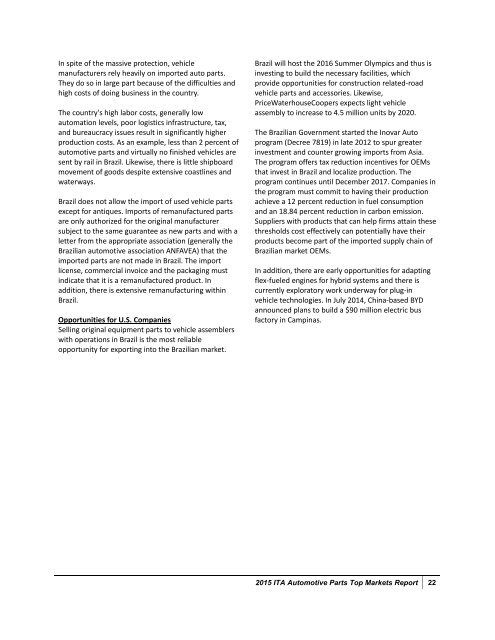In spite of the massive protection, vehiclemanufacturers rely heavily on imported auto parts.They do so in large part because of the difficulties andhigh costs of doing business in the country.The country's high labor costs, generally lowautomation levels, poor logistics infrastructure, tax,and bureaucracy issues result in significantly higherproduction costs. As an example, less than 2 percent ofautomotive parts and virtually no finished vehicles aresent by rail in Brazil. Likewise, there is little shipboardmovement of goods despite extensive coastlines andwaterways.Brazil does not allow the import of used vehicle partsexcept for antiques. Imports of remanufactured partsare only authorized for the original manufacturersubject to the same guarantee as new parts and with aletter from the appropriate association (generally theBrazilian automotive association ANFAVEA) that theimported parts are not made in Brazil. The importlicense, commercial invoice and the packaging mustindicate that it is a remanufactured product. Inaddition, there is extensive remanufacturing withinBrazil.Opportunities for U.S. CompaniesSelling original equipment parts to vehicle assemblerswith operations in Brazil is the most reliableopportunity for exporting into the Brazilian market.Brazil will host the 2016 Summer Olympics and thus isinvesting to build the necessary facilities, whichprovide opportunities for construction related-roadvehicle parts and accessories. Likewise,PriceWaterhouseCoopers expects light vehicleassembly to increase to 4.5 million units by 2020.The Brazilian Government started the Inovar Autoprogram (Decree 7819) in late 2012 to spur greaterinvestment and counter growing imports from Asia.The program offers tax reduction incentives for OEMsthat invest in Brazil and localize production. Theprogram continues until December 2017. Companies inthe program must commit to having their productionachieve a 12 percent reduction in fuel consumptionand an 18.84 percent reduction in carbon emission.Suppliers with products that can help firms attain thesethresholds cost effectively can potentially have theirproducts become part of the imported supply chain ofBrazilian market OEMs.In addition, there are early opportunities for adaptingflex-fueled engines for hybrid systems and there iscurrently exploratory work underway for plug-invehicle technologies. In July 2014, China-based BYDannounced plans to build a $90 million electric busfactory in Campinas.2015 ITA <strong>Automotive</strong> <strong>Parts</strong> Top Markets Report 22
South KoreaType: Large Market; Small ShareThe United States and Korea Free Trade Agreement (KORUS FTA)eliminates tariffs on over 95 percent of industrial and consumergoods within five years. For autos, the FTA attempts to addressautomotive safety standards and new Korean environmentalstandards that have served as barriers to U.S. exports to create amore open and fair market for U.S. auto companies.OriginalEquipmentRank12AftermarketRank18On March 15, 2012, the United States and Koreaagreed to bring into force the United States-Korea FreeTrade Agreement (KORUS FTA). Trade between theUnited States and Korea is bound by the terms of theKORUS FTA. The FTA was negotiated to increaseopportunities for U.S. businesses and exports ofAmerican goods. It eliminates tariffs on over 95percent of industrial and consumer goods within fiveyears.For autos specifically, the FTA attempts to addressautomotive safety standards and new Koreanenvironmental standards that have served as barriersto U.S. exports to create a more open and fair marketfor U.S. auto companies. KORUS contains provisionsdesigned to address nontariff barriers, includingKorean acceptance of U.S. automotive safety standardsfor motor vehicles built in the United States andregulatory transparency provisions. The agreementallows manufacturers that sell 25,000 or fewer U.S.-made autos and trucks in South Korea to import theirU.S.-made vehicles into South Korea by meeting U.S.federal safety standards rather than certifying toSouth Korean standards.The FTA also immediately cut Korea’s tariff on U.S.car exports in half from 8 to 4 percent, and it will befully eliminated in the fifth year. Korea immediatelyeliminated its 10 percent tariff on U.S. trucks. Sincethe ratification of the KORUS FTA, the tariff onautomotive parts and accessories, which are new orused is zero percent.In Korea, imported vehicles accounted for about 12percent of all vehicles in total market share in 2013.According to Ward’s, total production of vehicles inKorea was 4.66 million units in 2011, 4.56 million unitsin 2012, and 4.52 units in 2013. From the 2013numbers, 3.45 million were produced by Hyundai andKia, 782,721 by GM, and 129,638 by Renault. In 2013,930,910 cars were sold in Korea.Of these, the Hyundai Group led again with 622,438units sold, followed by GM with 98,642 units, Renaultwith 53,521 units, Volkswagen with 45,857 units, BMWwith 39,397 units, Daimler with 24,780 units, and Fordwith 7,214 units (each of the top three have assemblyplants in Korea). Chrysler also had sales of 4,143 cars in2013. Hyundai maintained a 41.6 percent marketshare, followed by Kia with 29.7 percent, and GM with9.8 percent. During this same time period, exports ofFigure 1: 2013 Korea <strong>Automotive</strong> MarketSales (units) 1,539,855U.S. Auto <strong>Parts</strong> Exports to $914,417,518South KoreaTotal Korean Auto <strong>Parts</strong> $10,393,165,658ImportsTotal Domestic Vehicle 4,521,429ProductionVehicles in Operation (2012) 14,577,182U.S. Auto <strong>Parts</strong> Export +202%Growth 2009-20142015 ITA <strong>Automotive</strong> <strong>Parts</strong> Top Markets Report 23


